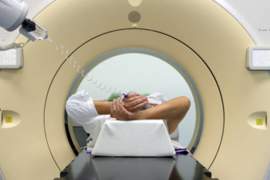
Diagnosing Mesothelioma

What is Mesothelioma? Mesothelioma is an uncommon type of cancer that forms from the alteration of cells in the mesothelium—protective lining of several internal organs. Mesothelioma cancer is typically caused by prolonged exposure to asbestos. Asbestos, when contacted, propels cancerous filaments into the air. When these filaments are perpetually inhaled over a long period of time they stick to the linings of the lung. The bulk of mesothelioma patients, therefore, were previously employed in industries that utilized asbestos. Although there are several forms of mesothelioma cancer, the majority of cases develop in the internal wall of the chest cavity or the lining of the lungs. Common symptoms attached to mesothelioma will include: shortness of breath, stemming from a build-up of fluid between the abdomen and lungs, weight loss and painful coughing. One of the primary characteristics—and the major reason why the disease is so deadly—stems from its insidious symptoms. Mesothelioma cancers are nearly impossible to detect in their early stages. The difficulty associated with diagnosis comes from the condition’s dormant symptoms. A mesothelioma sufferer will only notice symptoms 15-20 years after the initial infection takes place. Similar to other types of cancer, mesothelioma is categorized by stage--when the disease progresses the prognosis becomes more deadly. This insidious nature of mesothelioma cancer is paired with its inconspicuousness to create a deadly medical condition—mesothelioma patients typically die within 6 months-1 year of diagnosis. In most cases, mesothelioma cancers will not be diagnosed until the malignant tumors spread to the vital organs of the body. When the disease reaches stage III or stage IV it becomes inoperable. By chance, if mesothelioma cancer is caught before the cancer spreads, curable treatments, such as surgery, may be implemented to eliminate the malignant tumors. Moreover, several palliative surgeries may be administered to mitigate the suffering associated with mesothelioma cancer. Regardless of the operation, patients should exercise regularly to ease the symptoms and better prepare themselves for mesothelioma treatments. Diagnosing Mesothelioma: Because mesothelioma cancer symptoms are relatively innocuous while the disease is in its early stages, misdiagnosis or a failure to diagnose the disease is very common. Mesothelioma cancer takes an extremely long time to incubate within a human body before symptoms of the disease may appear and cause tangible suffering to the patient. Often times, it takes fifteen to twenty years for mesothelioma cancer to fully present itself and unfortunately by this time, the damage has already been done. These characteristics present a difficult challenge for the medical community regarding the accurate diagnosis of mesothelioma cancer. If a prospective mesothelioma patient notes a history of asbestos exposure or contamination a medical professional will immediately inspect for signs of mesothelioma cancer. To do this, medical professionals will examine the lining and tissues surrounding the heart, lungs and stomach areas. Prospective mesothelioma patients will likely begin a physical examination to determine the causes of the patient’s symptoms. This examination will typically involve chest and lung x-rays if the individual is reporting difficulty breathing (a common ailment associated with mesothelioma cancers). In this instance, a medical professional will also request a number of pulmonary procedures to examine the area surrounding the lungs. Follow up CT scans and MRI tests will also be administered if these preliminary examinations show a strong probability of mesothelioma cancer. MRI tests and CT scans are essential tools for diagnosing mesothelioma; these tools can also aid the doctor or medical professional in determining the location and exact size of any tumors that may have developed from the asbestos exposure. Following a review of MRI and CT pictures, a medical professional will request a biopsy of the affected region. During this procedure, the medical professional will remove a piece of tissue from the affect region where mesothelioma cancer is suspected. Once the biopsy is performed the tissue sample can be further examined to determine the type of mesothelioma cancer that is currently affecting the patient. Tissues that come back as benign will typically mean that the mesothelioma tumor is not cancerous. However, malignant mesothelioma cancers are cancerous and pose severe threats to the life and health of the patient. Steps to Diagnosing Mesothelioma Cancer: If you or a loved one has a history of asbestos exposure and is currently bothered by a persistent cough, shortness of breath or unexpected and severe weight loss, a trip to the doctor is necessary. As stated above, mesothelioma cancer is exceedingly difficult to diagnose in its early stages. As a result, it is highly recommended to engage in the following steps with your medical professional if you have a long history of handling asbestos: 1. Physical Examinations: The first step to accurately diagnosing mesothelioma is to engage in a physical examination. As is common with all medical conditions, a medical professional will begin the mesothelioma diagnosis by doing a complete physical examination. In addition to the physical examination, the doctor will also review your medical history. Because mesothelioma cancer is almost always caused by inhaling asbestos exposure, you must tell your medical professionals about your history with asbestos exposures if you suspect you have any asbestos-related diseases. After your physical examination is over, the medical professional should x-ray your chest, and in some cases, should perform pulmonary function tests to determine if the symptoms are accurate and consistent with malignant forms of mesothelioma cancer. 2. MRI’s and CT Scans to Diagnose Mesothelioma: In most cases, medical professionals will order CT scans and MRI’s to help accurately diagnose mesothelioma. These examination tools enable medical professionals to assess the location, size and extent of the mesothelioma tumors in the abdomen or chest cavity. 3. Biopsy to Diagnose Mesothelioma Cancer: The above steps to diagnose mesothelioma are primarily attributed to only preliminary indicators regarding mesothelioma cancers. If, after performing these examinations, a medical professional suspect mesothelioma cancer, a biopsy will be performed to confirm the mesothelioma diagnoses. 4. Biopsies: This procedure is used to obtain tissue samples of the tumors or affected areas. The two most widely-used methods for extracting tissue samples are broncoscopies and a thorascoscopy. A bronchoscopy requires the medical professional to insert a flexible lighted tube through the mouth into the bronchi to remove your tissue in the airway. This type of biopsy is used for diagnosing pleural mesothelioma cancers. By contrast, a thoracoscopy, is obtained by inserting telescope-like instruments, which are connected to video cameras, into a small incision in the chest cavity. The medical professional will then remove the tumor using special forceps with the help of the camera. This type of biopsy is used to diagnosing both pericardial mesothelioma and pleural mesothelioma. Although biopsies are the most productive procedure for diagnosing mesothelioma cancers, malignant mesothelioma cancer cells are nearly identical (with regards to size and shape) with other types of cancer. Therefore, special lab tests are performed or special diagnostic tools are used to confirm a mesothelioma diagnosis.



















